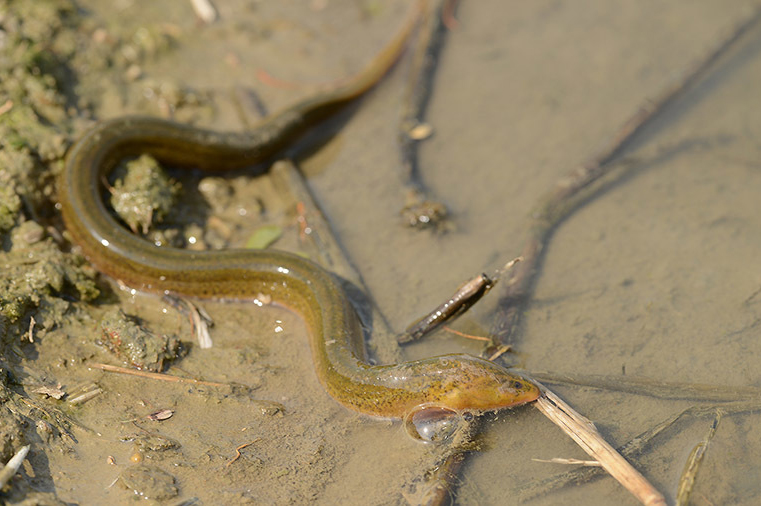Belut, Monopterus albus (Zuiew 1793)

A Belut, Monopterus albus, in South Korea, May 2014. Source: Kim, Hyun-tae / iNaturalist.org. License: CC by Attribution
The Belut, Monopterus albus, is a medium to large-sized eel-like fish that lives mostly in freshwater. The dorsal, anal and caudal fins are continuous and appear as a fin-fold, and the gill openings are united into a triangular slit beneath the head. The species is a protogynous hermaphrodite, meaning that individuals change sex from females to males. Males care for the developing eggs inside their nest burrows. Once the larvae hatch, the males brood them inside their mouths.
Belut, Monopterus albus (Zuiew 1793)
More Info
|
Distribution |
Widespread in tropical freshwaters from India, Bangladesh, throughout Southeast Asia, China, Japan, and introduced to the USA. Known in Australia from Cape York to Townsville, Queensland. The Belut is a bottom-dwelling fish found in still water in muddy swamps, ponds and sometimes in quiet flowing streams. The species may also be found in brackish water and in temporary water bodies. |
|
Features |
Head and body: Body eel-like, elongate, robust. Head short and broad with thick lips and small eyes. The eyes are covered by dense skin, and positioned well-forward on the head, almost above middle of upper lip. Anterior and posterior nostrils are present. The fused gill membranes form a large, triangular gill opening beneath the back of head that lacks a separate or swollen lateral fold. Gills if present resemble a thin ridge of tissue. Teeth are present on the premaxilla, dentary, palatine, and ectopterygoid bones.Scales are absent. Vertebrae: 88 to 102 abdominal and 45 to 74 caudal vertebrae. Fins: Dorsal and anal fins are reduced to folds of skin on the posterior part of body. Pectoral and pelvic fins are absent. |
|
Size |
To 1 metre TL, commonly to 40 cm. |
|
Colour |
Body overall brown to greyish, often with dark spots on the back and sides. the ventral surface is pale yellow or white. |
|
Feeding |
Carnivores, feeding on small fishes, frogs, tadpoles and invertebrates such as freshwater crayfish and earthworms. The Belut also feeds on detritus. |
|
Biology |
The Belut is a protogynous hermaphrodite, meaning that individuals change sex from female to male. Male swamp eels are territorial and build nest burrows in soft sediment. They defend their small territory against other males. Males breed with more than one female and visiting females are welcomed and courted. Females reportedly may lay up to 850 eggs over several nights. Males create a bubble bed inside their burrows and males keep the spawned eggs. Newly hatched larvae remain in the bubble bed, before being brooded in the male's mouth. Larvae are brooded inside the mouth until they are several centimetres long. Eggs: Large (3.3-4.6 mm), yolky, orange coloured. Larvae: Hatch after 10 days at 28-32°C and the yolk sac is absorbed in 4 days. Larvae have pectoral and median fins at hatching but the pectorals disappear after 8 days and median fins become progressively smaller from 21 days post-hatching. |
|
Fisheries |
Although of no interest to fisheries in Australia, they are farmed throughout Southeast Asia. If their skin is moist they can be kept alive for a long time and are reportedly good eating. |
|
Conservation |
Monopterus albus has been recently assessed as Least Concern on the IUCN (International Union for Conservation of Nature) Red List of Threatened Species (Dahanuker, 2010). |
|
Remarks |
The Belut has very reduced gills and is mostly an air breather. During dry periods it can survive for long periods in burrows into the moist sediment. The species has been intentially introduced to other parts of the world from its native habitat. Monopterus albus is widely distributed and is currently thought to be species complex. |
|
Species Citation |
Muraena alba Zuiew, B. (1793). Biga muraenarum, novae species descriptae. Nova Acta Acad. Sci. Petropolitanae 7: 296–301 figs & pls [299 pl. 7 fig. 2]. Type locality: Suriname. |
|
Author |
Dianne J. Bray & Vanessa J. Thompson |
Belut, Monopterus albus (Zuiew 1793)
References
Allen, G.R. 1989. Freshwater Fishes of Australia. Neptune, New Jersey : T.F.H. Publications pp. 1–240.
Allen, G.R., Midgley, S.H. & Allen, M. 2002. Field guide to the freshwater fishes of Australia. Perth : Western Australian Museum 394 pp.
Dahanukar, N. 2010. Monopterus albus. In: IUCN 2011. IUCN Red List of Threatened Species. Version 2011.1. .
Liem, K.F. 1963. Sex reversal as a natural process in the synbranchiform fish Monopterus albus. Copeia 1963: 303–312.
Liem, K.F. 1968. Geographical and taxonomic variation in the pattern of natural sex reversal in the teleost fish order Synbranchiformes. J. Zool. Lond. 156: 225–238.
Liu, C.K. & Hu, S.H. 1980. Egg and larva development of the mud eel, Monopterus albus. Bull. Taiwan Fish. Res. Inst. 1980: 557–562.
Liu, P.-K. & Liu, C.-K. 1983. Culture and induced breeding of rice-field eel Monopterus albus. Bull. Taiwan Fish. Res. Inst. (35):93-95.
Matsumoto, S. & Iwata, K. 1997. Paternal egg guarding and mouth brooding in the bubble nest of the swamp eel, Monopterus albus. Jpn J. Ichthyol. 44: 35–41. (in Japanese)
Matsumoto, S., Kon, T., Yamaguchi, M., Takeshita, H., Yamazaki, Y., Mukai, T., Kuriiwa, K., Kohda, M. & Nishida, M. 2009. Cryptic diversification of the swamp eel Monopterus albus in East and Southeast Asia, with special reference to the Ryukyuan populations. Ichthyol. Res. 57: 71–77.
Matsumoto, S., Takeyama, T., Ohnishi, N. & Kohda, M. 2011. Mating system and size advantage of male mating in the protogynous swamp eel Monopterus albus with paternal care. Zoological Science 28(5):360-367.
Merrick, J.R. & Schmida, G.E. 1984. Australian Freshwater Fishes Biology and Management. Sydney : J.R. Merrick 409 pp.
Pusey B., Kennard M. & Arthington A. 2004. Freshwater Fishes of North-Eastern Australia. CSIRO Publishing, Collingwood, Victoria.





